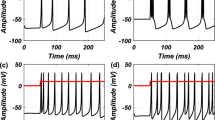Abstract
Because of the human brain’s parallel computing structure and its characteristics of the localized storage, the human brain has great superiority of high throughput and low power consumption. Based on the bionics of the brain, many researchers try to imitate the behavior of neurons with hardware platform so that we can obtain the same or close computational acceleration performance like the brain. In this paper, we proposed a hardware structure to implement single neuron with Integration-and-Fire(IF) model on Virtex-7 XC7VX485T-ffg1157 FPGA. Through simulation and synthesis, we quantitatively analyzed the device utilization and power consumption of our structure; meanwhile, the function of the proposed hardware implementation is verified with the classic XOR benchmark with a 4-layer SNN and the scalability of our hardware neuron is tested with a handwritten digits recognition mission on MNIST database using a 6-layer SNN. Experimental results show that the neuron hardware implementation proposed in this paper can pass the XOR benchmark test and fulfill the need of handwritten digits recognition mission. The total on-chip power of 4-layer SNN is 0.114 W, which is the lowest among the ANN and firing-rate based SNN at the same scale.
Supported by Advanced General Chip, Project Name: The Design of Supercomputer Chip, NO. 2017ZX01028-103.
Access this chapter
Tax calculation will be finalised at checkout
Purchases are for personal use only
Similar content being viewed by others
References
Merolla, P.A., et al.: A million spiking-neuron integrated circuit with a scalable communication network and interface Science. Science 345(6197), 668–673 (2014)
Schrauwen, B., van Campenhout, J.: Parallel hardware implementation of a broad class of spiking neurons using serial arithmetic. In: ESANN, pp. 623–628 (2006)
Moreno, J., Thoma, Y., Sanchez, E., Eriksson, J., Iglesias, J., Villa, A.: The POEtic electronic tissue and its role in the emulation of large-scale biologically inspired spiking neural networks models. Complexus 3(1–3), 32–47 (2006). https://doi.org/10.1159/000094186
Hampton, A.N., Adami, C.: Evolution of robust developmental neural networks. In: Artificial Life IX. The Ninth International Conference on the Simulation and Synthesis of Living Systems (2004)
Floreano, D., Epars, Y., Zufferey, J., Mattiussi, C.: Evolution of spiking neural circuits in autonomous mobile robots. Int. J. Intell. Syst. 20, 100 (2005)
Carlson, N.: Foundations of Physiological Psychology. Simon & Schuster, Needham Heights (1992)
Schuman, C.D., et al.: A Survey of Neuromorphic Computing and Neural Networks in Hardware (2017)
Bonabi, S.Y., Asgharian, H., Bakhtiari, R., Safari, S., Ahmadabadi, M.N.: FPGA implementation of a cortical network based on the Hodgkin-Huxley neuron model. Front. Neurosci. 8, 379 (2014)
Rice, K.L., Bhuiyan, M.A., Taha, T.M., Vutsinas, C.N., Smith, M.C.: FPGA implementation of Izhikevich spiking neural networks for character recognition. In: International Conference on Reconfigurable Computing and FPGAs. Reconfig, pp. 451–456. IEEE (2009)
Millner, S., Grübl, A., Meier, K., Schemmel, J., Schwartz, M.O.: A VLSI implementation of the adaptive exponential integrate-and-fire neuron model. Adv. Neural Inf. Process. Syst. 23, 1642–1650 (2010)
Izeboudjen, N., Farah, A., Titri, S., Boumeridja, H.: Digital implementation of artificial neural networks: From VHDL description to FPGA implementation. In: Mira, J., Sánchez-Andrés, J.V. (eds.) IWANN 1999. LNCS, vol. 1607, pp. 139–148. Springer, Heidelberg (1999). https://doi.org/10.1007/BFb0100480
Benjamin, B.V.: Neurogrid: a mixed-analog-digital multichip system for large-scale neural simulations. Proc. IEEE 102, 699–716 (2014)
Furber, S.B., et al.: The SpiNNaker project. Proc. IEEE 102, 652–665 (2014)
Shayani, H., et al.: Hardware implementation of a bio-plausible neuron model for evolution and growth of spiking neural networks on FPGA. In: NASA/ESA Conference on Adaptive Hardware and Systems, pp. 236–243 (2008)
Maguire, L.P.: Challenges for large-scale implementations of spiking neural networks on FPGAs. Neurocomputing 71, 13–29 (2007)
Morgan, F., et al.: Exploring the evolution of NoC-based Spiking Neural Networks on FPGAs. In: International Conference on Field-Programmable Technology, pp. 300–303 (2009)
Wang, R.: Neuromorphic hardware architecture using the neural engineering framework for pattern recognition. IEEE Trans. Biomed. Circuits Syst. 11, 574–584 (2017)
Kistler, W., Werner, M.: Spiking Neuron Models. Cambridge University Press, New York (2002)
Schemmel, J., et al.: A wafer-scale neuromorphic hardware system for large-scale neural modeling. IEEE International Symposium on Circuits and Systems (2010). https://doi.org/10.1109/ISCAS.2010.5536970
Stimberg, M., et al.: Equation-Oriented Specification of Neural Models for Simulations (2014). https://doi.org/10.3389/fninf.2014.00006
Maher, J., McGinley, B., Rocke, P., Morgan, F.: Intrinsic hardware evolution of neural networks in reconfigurable analogue and digital devices. In: 14th Annual IEEE Symposium on Field-Programmable Custom Computing Machines, FCCM, Seattle, pp. 321–322 (2006)
Author information
Authors and Affiliations
Corresponding author
Editor information
Editors and Affiliations
Rights and permissions
Copyright information
© 2018 Springer Nature Singapore Pte Ltd.
About this paper
Cite this paper
Wang, S. et al. (2018). A Power Efficient Hardware Implementation of the IF Neuron Model. In: Li, C., Wu, J. (eds) Advanced Computer Architecture. ACA 2018. Communications in Computer and Information Science, vol 908. Springer, Singapore. https://doi.org/10.1007/978-981-13-2423-9_11
Download citation
DOI: https://doi.org/10.1007/978-981-13-2423-9_11
Published:
Publisher Name: Springer, Singapore
Print ISBN: 978-981-13-2422-2
Online ISBN: 978-981-13-2423-9
eBook Packages: Computer ScienceComputer Science (R0)





